Sales promotions are a great way to market your business to drive sales and boost customer engagement. Whether you're launching a new product, clearing out seasonal inventory, or trying to attract new customers, the right promotion can make all the difference. In this article, LitExtension will explore 25+ sales promotion examples to help you maximize the impact of your promotional efforts.
Here's our agenda today:
- A sales promotion definition;
- 25+ effective sales promotion examples;
- Where to share sales promotions;
- Key takeaways on sales promotion examples.
What Is a Sales Promotion?
Definition of sales promotion
A sales promotion is a limited-time offer designed to generate immediate customer interest and boost sales. Businesses use promotions to encourage purchases by either lowering the price, such as with discounts or increasing the perceived value, like offering free gifts. These strategies are often applied during major sales events, product launches, or as part of a larger marketing plan.
Sales promotions take various forms:
- Discount-based promotions: Percentage discounts, coupons, and flash sales.
- Engagement-based promotions: Contests, giveaways, and loyalty programs.
- Product-focused promotions: Buy-one-get-one (BOGO) deals, product bundling, and free samples.
Each type serves a different purpose and targets specific consumer behaviors, which makes it critical to choose the right one for your campaign.
Purpose and goals of sales promotions
The main goal of a sales promotion is to motivate customers to make a purchase they might not have considered. However, the specific objectives can vary depending on the business's needs.
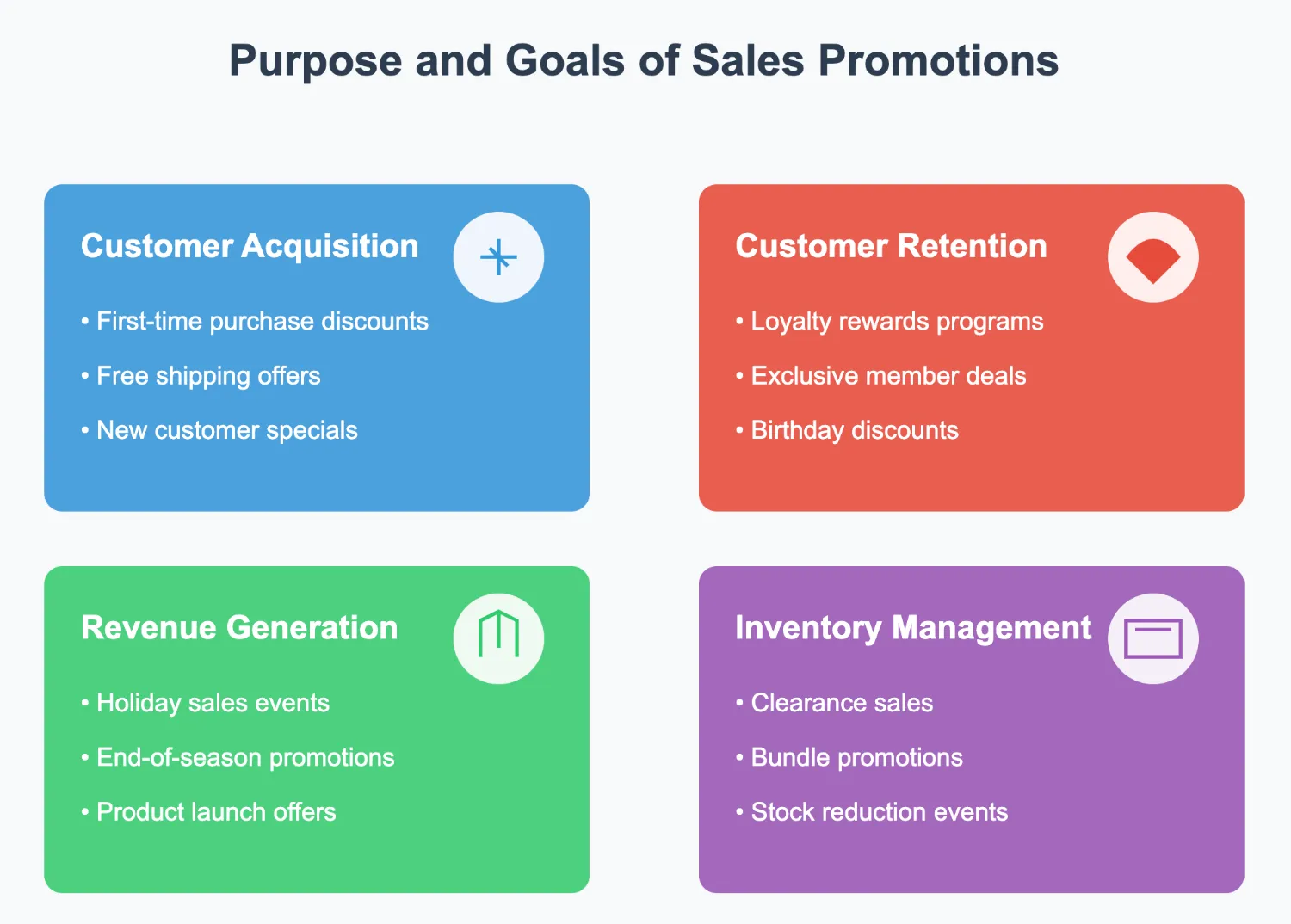
Common goals include:
- Attract new customers with enticing offers like first-time purchase discounts or free shipping.
- Strengthen relationships with existing customers through loyalty rewards, exclusive member deals, or birthday discounts.
- Drive short-term sales during key periods such as holidays, end-of-season events, or product launches.
- Clear out excess inventory with clearance sales or bundle promotions.
Sales promotions also serve additional purposes. They can increase brand awareness, introduce new products to the market, and enhance customer engagement through sales promotion activities like social media contests.
Pros and Cons of Sales Promotions
Sales promotions offer various advantages, but they also present some risks. As a small or medium-sized business owner, it's essential to understand both the benefits and drawbacks of promotional campaigns.
Pros of sales promotions
- Promotions like discounts or free gifts attract new customers, especially price-sensitive ones.
- Flash sales, sitewide discounts, or holiday promotions can drive a rapid increase in sales, providing a quick revenue boost.
- Promotions often attract attention, whether through advertising or word-of-mouth.
Cons of sales promotions
- Offering deep or frequent discounts can reduce profit margins, especially for small businesses.
- Frequent discounts can devalue your brand, making customers associate it with lower-quality products.
- Running too many promotions can train customers to wait for sales rather than paying full price.
These sales promotion examples show what’s possible when campaigns are launched at the right time. To apply the same ideas consistently, you need a clear plan for the entire year.
25+ Brilliantly Effective Sales Promotion Examples
The key to the best sales promotions is choosing the right offer that resonates with your audience. Below are 25+ proven sales promotion examples, each designed to drive sales, improve customer engagement, or build brand loyalty.
1. BOGO specials
BOGO offers are a popular way to increase sales by encouraging customers to buy more. By offering a second item for free, businesses can move inventory quickly and provide added value to customers. This promotion appeals to consumers looking for immediate savings while businesses benefit from increased sales volume.
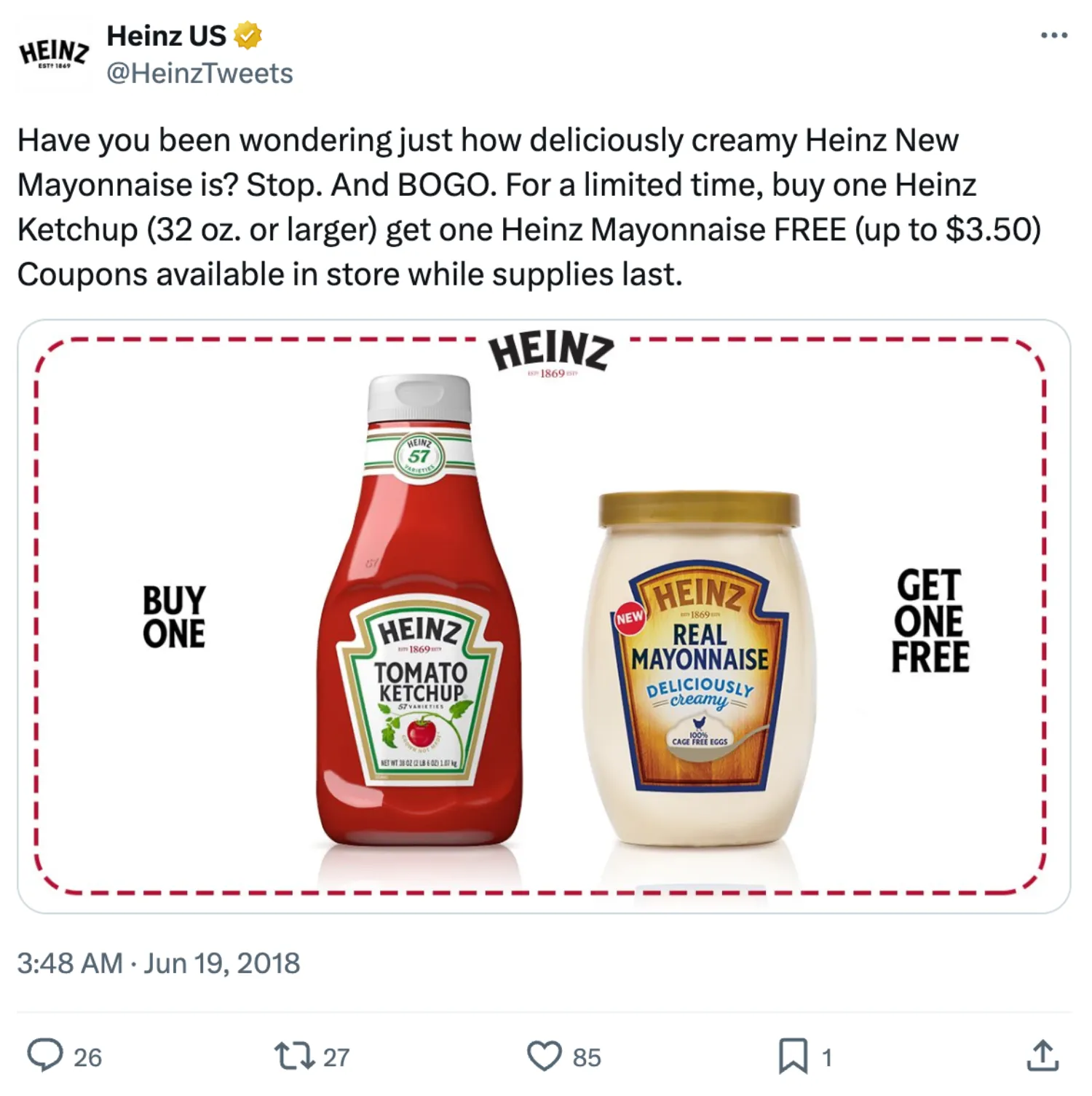
A well-known brand that frequently runs buy one, get one free (BOGO) offers is Kraft Heinz. They often have promotions on various food products, such as ketchup and mayonnaise, encouraging customers to purchase more while enjoying immediate savings.
2. Flash sales
Flash sales offer large discounts for a limited time, typically 24 hours or less. These promotions create urgency, driving quick bursts of traffic and helping clear inventory. Flash sales are particularly effective in eCommerce, where customers are drawn to time-sensitive deals.

For example, Muscle & Strength runs a 24-hour flash sale that offers substantial discounts on various fitness products. This promotion encourages customers to act quickly to take advantage of limited-time deals, such as up to 50% off select items. The urgency created by the short time frame is designed to drive immediate traffic and sales.
3. Free gift with purchase
A free gift with purchase is a widely used sales promotion technique that encourages customers to spend more by offering a complimentary item once they meet a certain purchase threshold. This strategy increases the average order value and enhances customer satisfaction. It is especially effective in industries like beauty, fashion, and health, where small, high-value add-ons elevate the perceived value of the purchase.
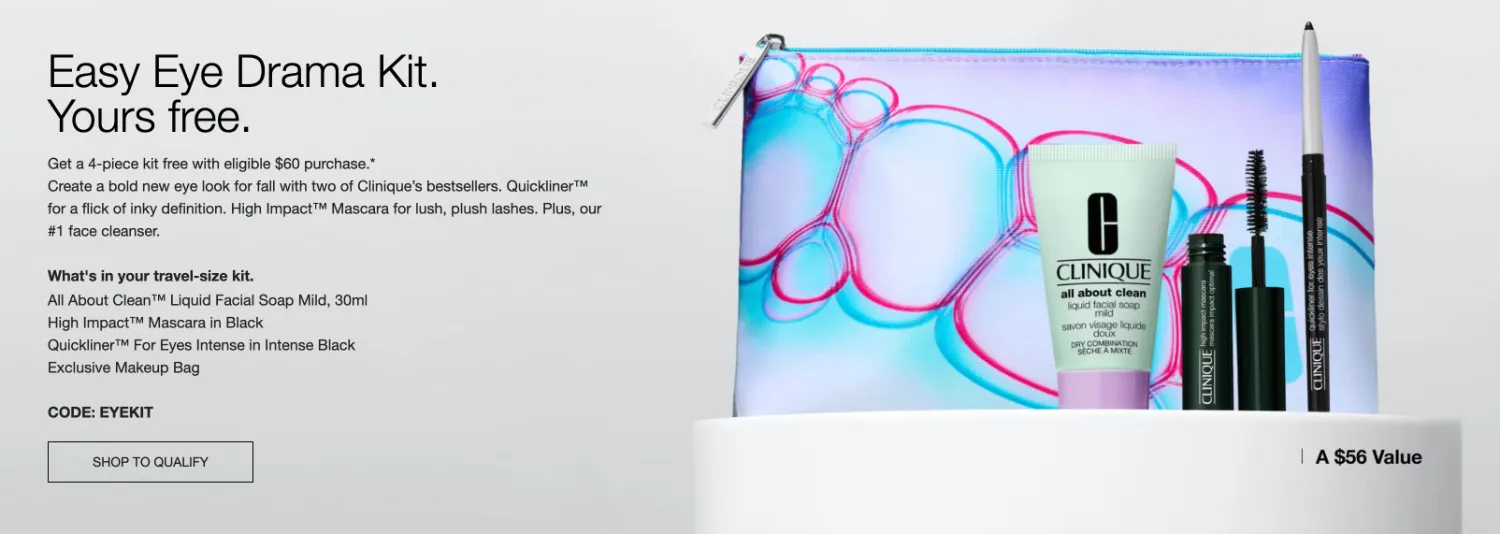
For example, Clinique is currently offering the Easy Eye Drama Kit as a free gift with an eligible purchase of $60 or more. This promotion encourages customers to spend more while providing valuable products that enhance their beauty routine.
As you see, free gift promotions drive customer loyalty and repeat purchases by making shoppers feel appreciated. It’s a win-win: businesses move more products, and customers leave with extra value.
4. Lifestyle discounts
Lifestyle discounts target specific demographic groups, such as students, seniors, or military personnel, offering them exclusive deals based on their identity. This type of promotion helps businesses tap into niche markets and build brand loyalty among targeted groups.
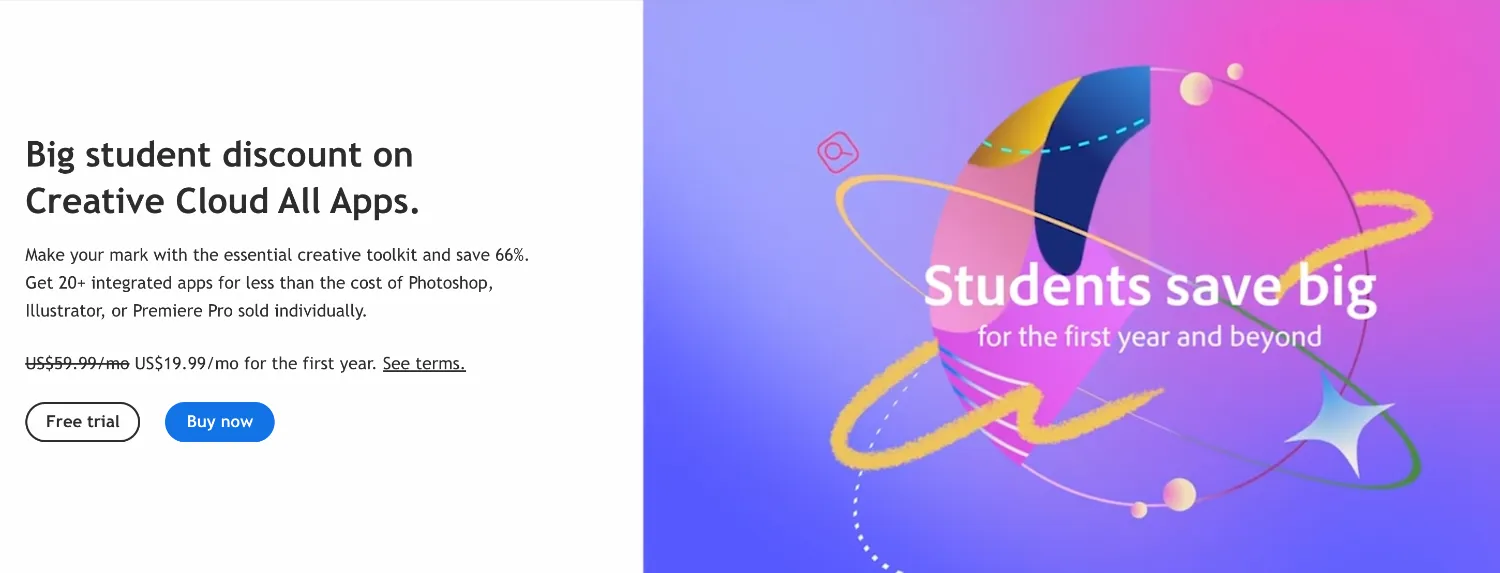
A notable example of a brand offering lifestyle discounts is Adobe. They provide a 66% discount on their Creative Cloud subscriptions for students and teachers. This promotion attracts young professionals and college students and helps Adobe build brand loyalty among future creatives.
5. Sitewide discount sale
A sitewide discount sale offers a uniform price reduction across an entire website. This promotion is commonly used on Black Friday campaigns or holiday weekend deals when customers are searching for deals. A sitewide sale boosts website traffic and attracts both new and returning customers. It drives a significant increase in sales over a short period.
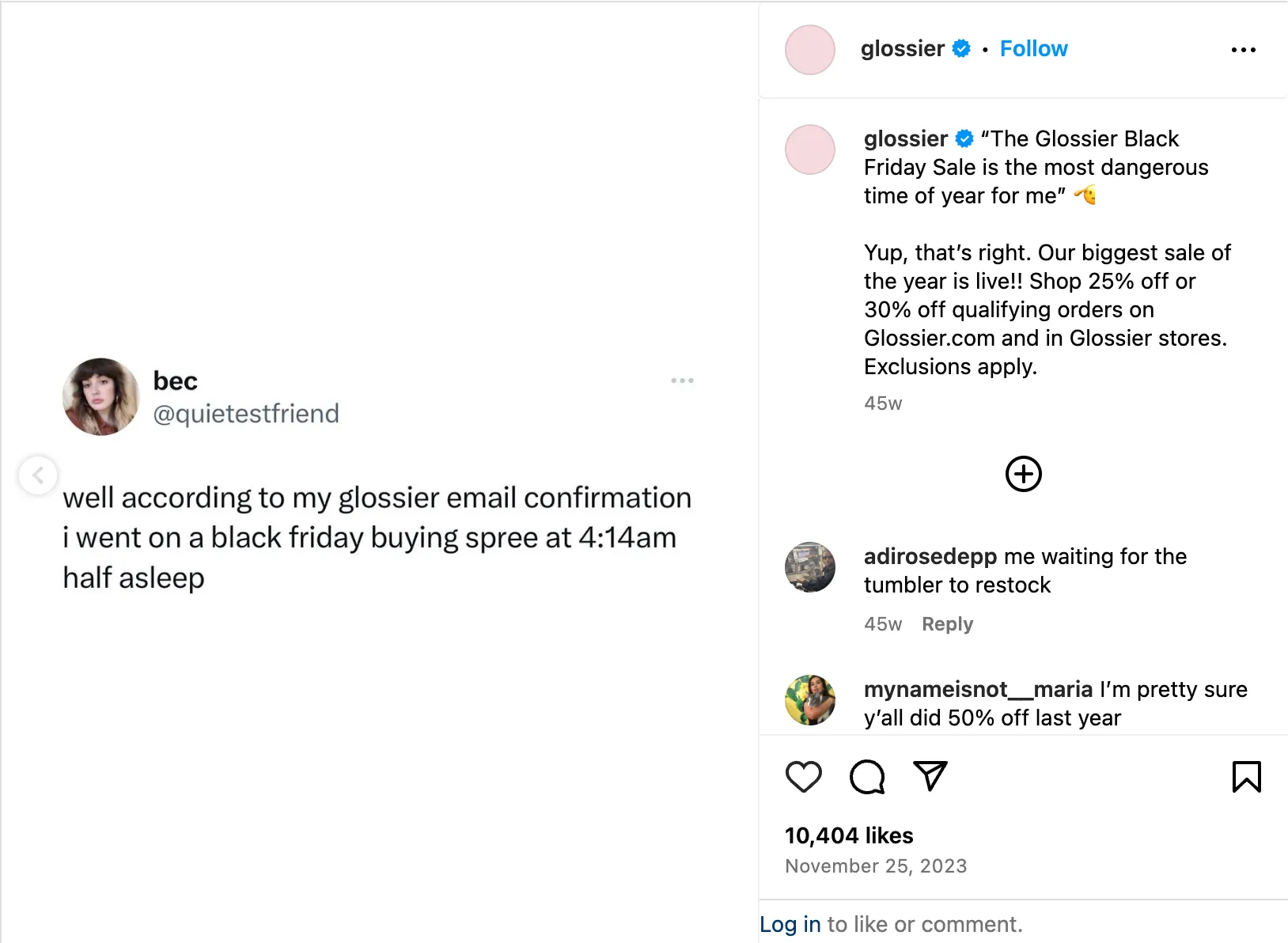
In 2023, Glossier featured 25% off site-wide on all products, an increased discount of 30% off for orders exceeding $100, and a free Glossier candle with purchases over $125.
Sitewide discount sales are highly successful at driving large traffic volumes and conversions, especially during high-traffic shopping periods. However, it’s important to carefully plan these promotions to avoid impacting profit margins too severely.
6. First purchase coupons
First purchase coupons are sales promotion examples for attracting new customers and encouraging first-time purchases. By offering a financial incentive, businesses can reduce the barrier to entry for potential buyers who may be hesitant to try a new product or service. These coupons can be distributed via email, social media, or online ads, reaching a broad audience to increase conversions.
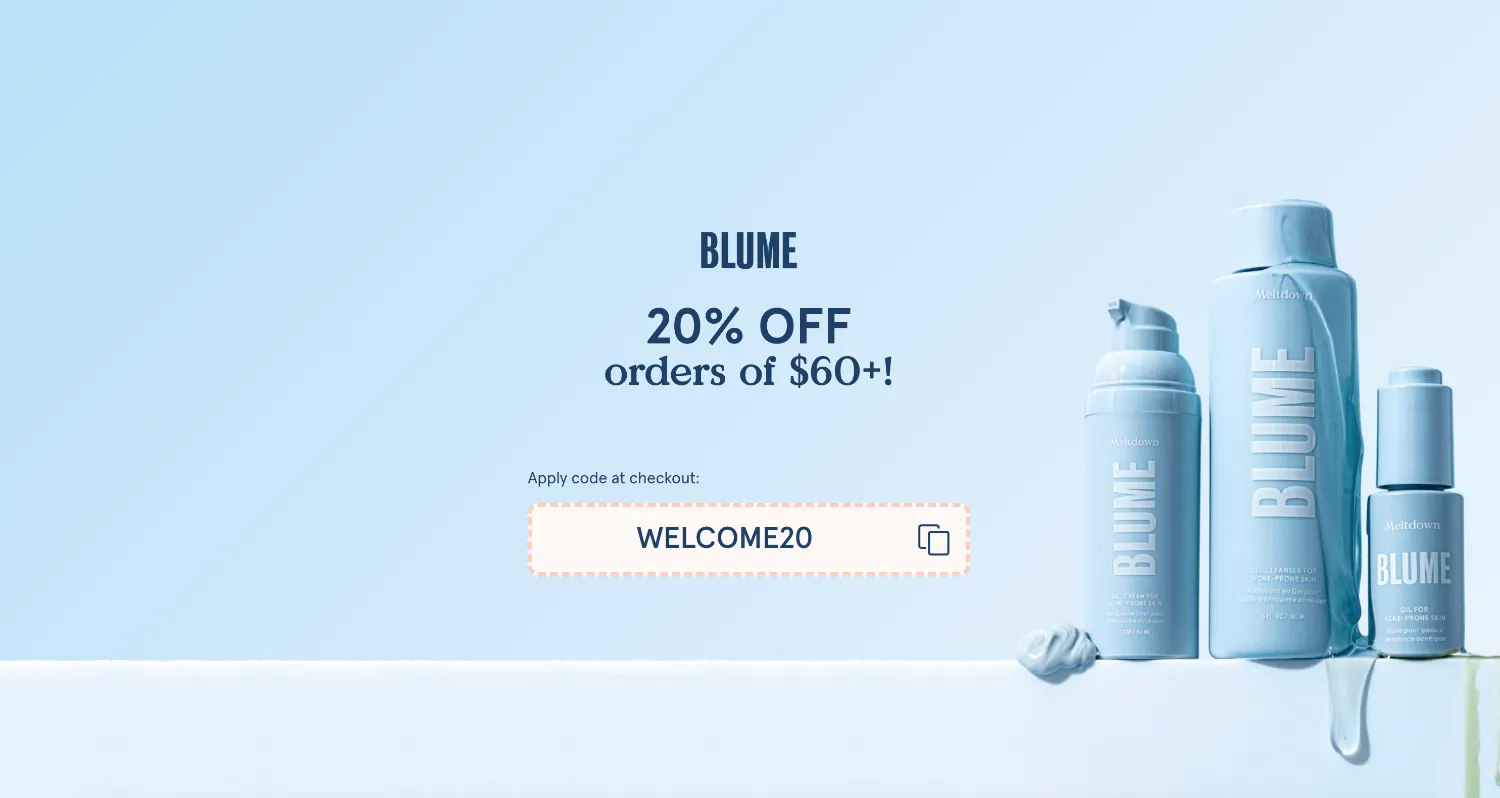
Blume, a skincare and personal care company, is a great example of a brand that offers discount coupons for new customers. They provide a 20% discount for first-time buyers who sign up for their email newsletter. This strategy not only incentivizes new customers to make a purchase but also helps Blume grow its email list for future marketing efforts.
7. Free samples
Free samples are a sales promotion tactic where businesses offer a product or service at no cost to allow potential customers to try it before making a purchase. This strategy helps build brand awareness and encourages customers to buy.
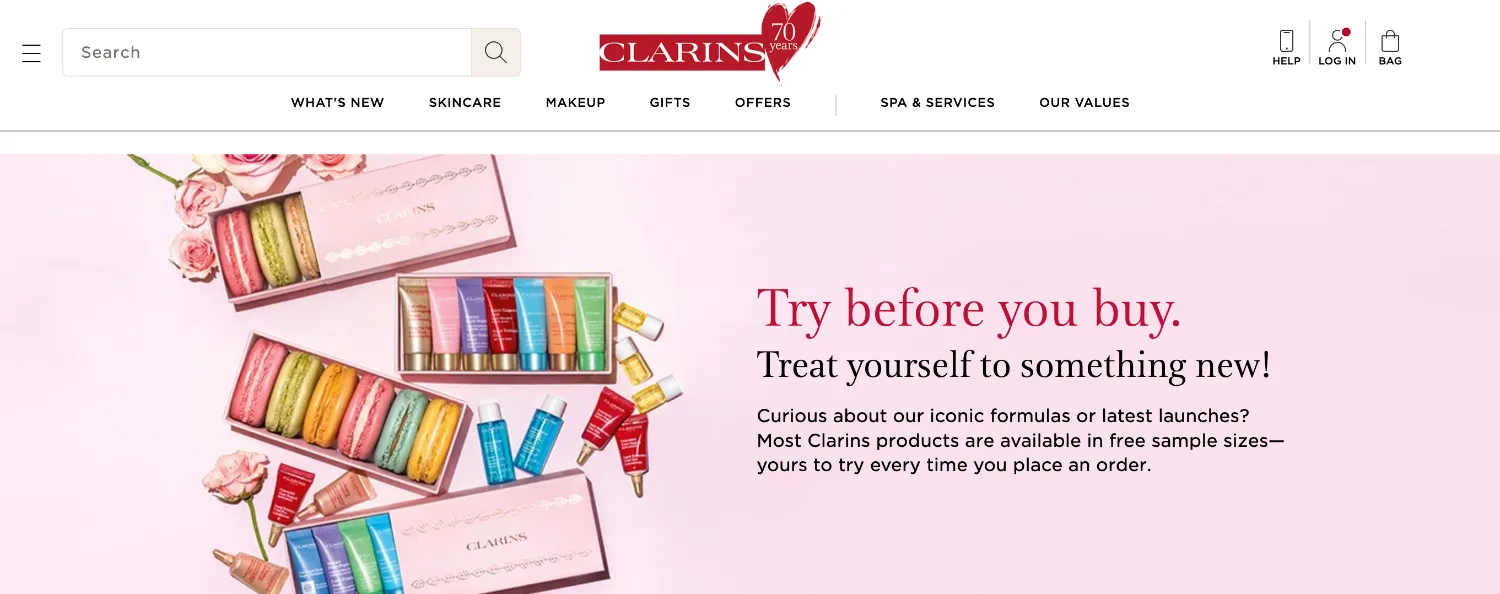
A great example of a brand that offers free samples, particularly in the cosmetics sector, is Clarins. They provide customers with the opportunity to choose three free samples of their skincare and makeup products with any order placed on their website.
8. End-of-season sales
End-of-season sales help businesses clear out old inventory to make room for new stock. These sales offer significant discounts on items that are no longer in season, appealing to deal-seeking customers. Businesses benefit from reduced overstock and storage costs, while customers enjoy great savings.
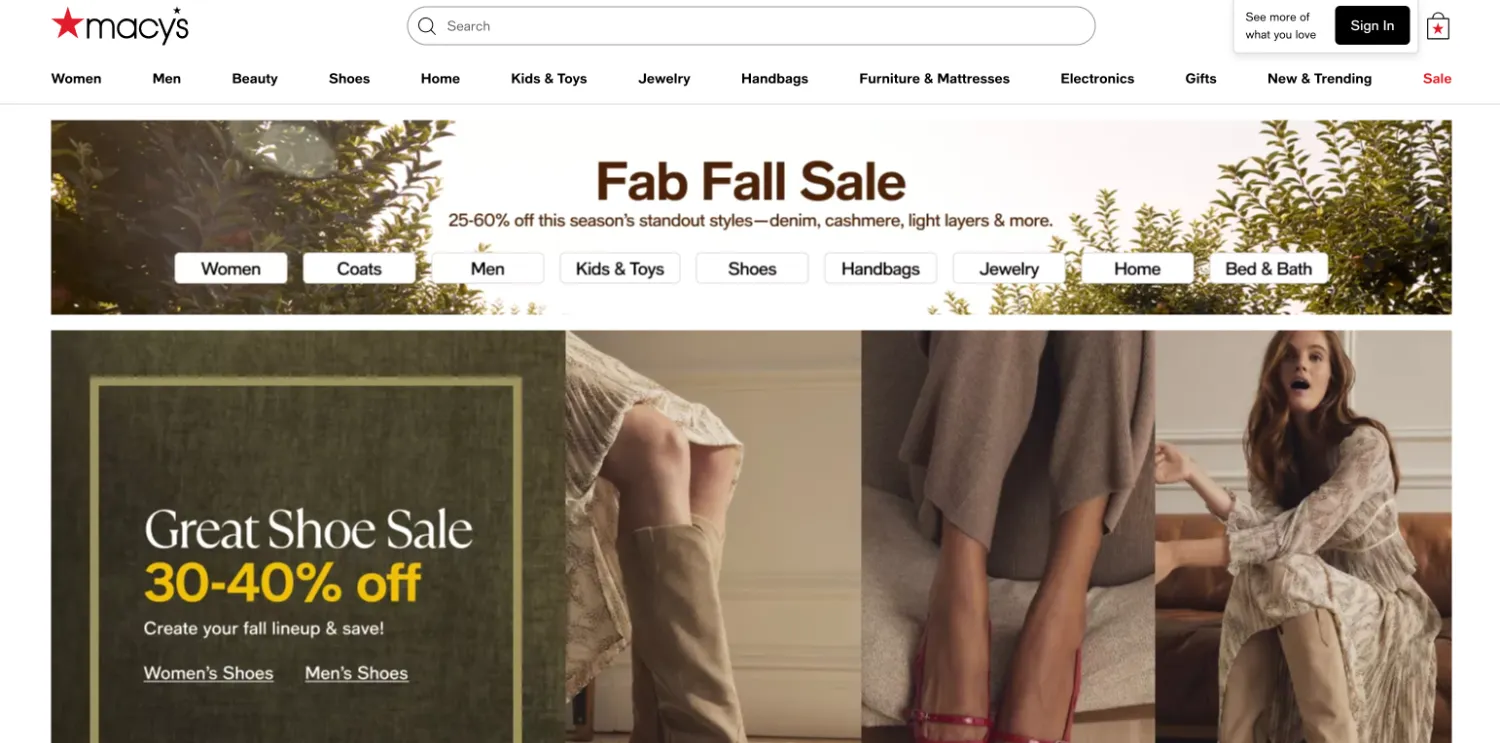
A well-known brand that effectively utilizes end-of-season sales is Macy's. They frequently offer significant discounts on seasonal clothing, such as 25-60% off fall apparel at the start of winter, allowing them to clear out inventory and make way for new collections.
This strategy not only helps Macy's manage stock levels but also attracts bargain-seeking customers looking for great deals.
9. Spin-the-wheel giveaways
Spin-the-wheel giveaways add gamification to sales promotions, offering customers chances to win discounts or free products. This fun and interactive approach keeps customers engaged and encourages them to stay on your site longer, increasing the likelihood of a purchase. These promotions are especially effective for eCommerce platforms looking to boost conversions.
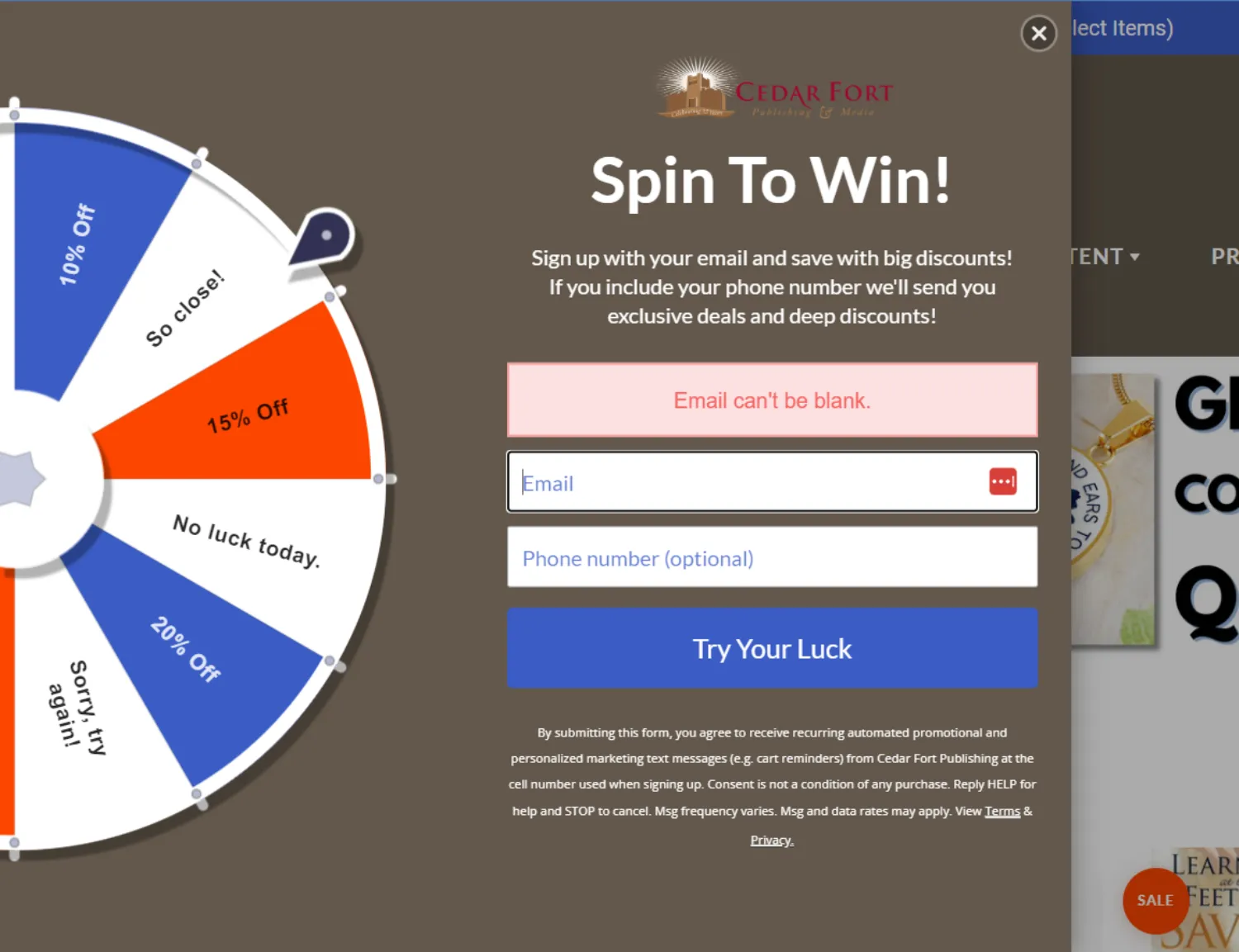
Cedar Fort, an eCommerce company, uses a spin-the-wheel feature for prizes like 10-20% discounts. Customers spin in exchange for signing up with their email, which also helps build the company’s marketing list.
10. Loyalty programs
Loyalty programs reward customers for repeat business, fostering long-term relationships. Through points, discounts, or special offers, businesses can encourage customer retention and create a loyal customer base that returns regularly.
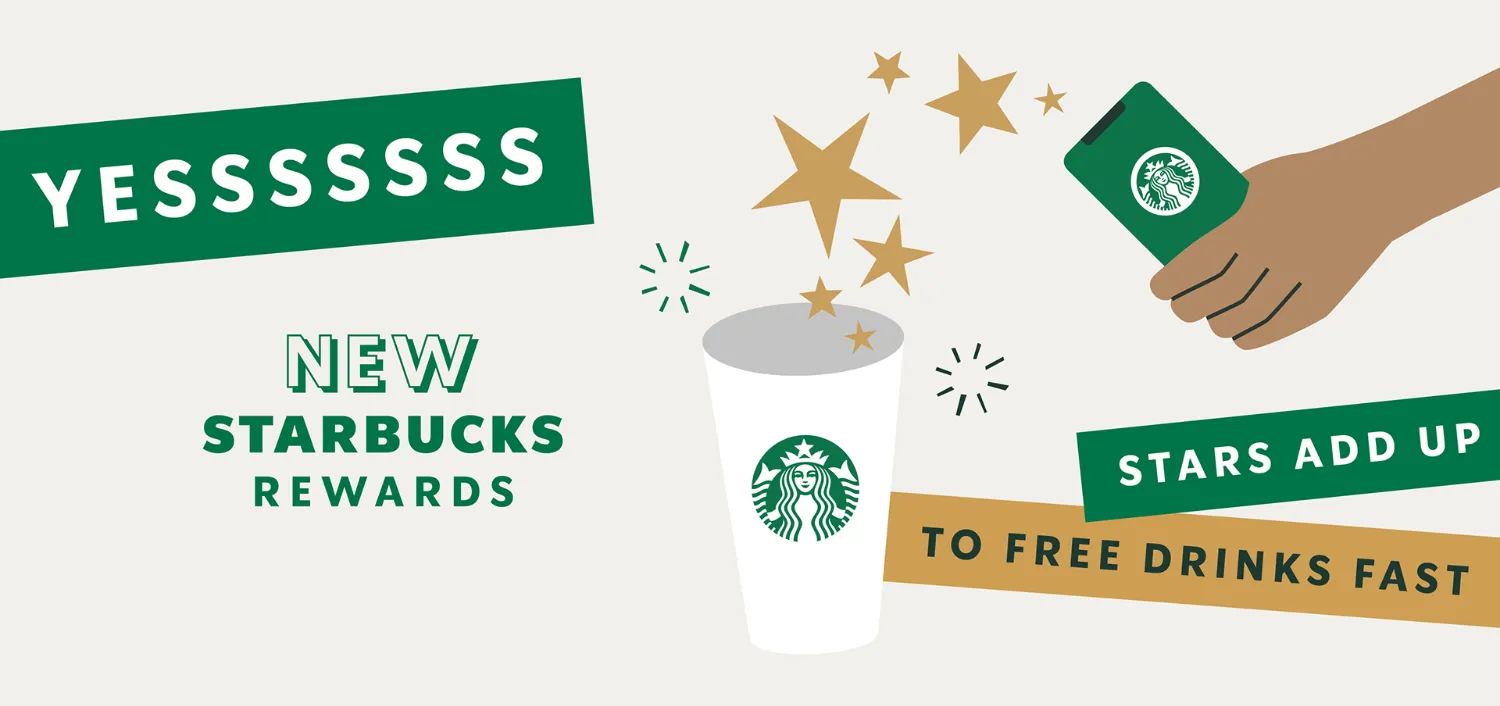
A great example of a brand with a loyalty program is Starbucks. They offer a rewards program where customers earn stars for every purchase, which can be redeemed for free drinks, food items, and exclusive discounts. This program encourages repeat visits and enhances customer loyalty.
11. Referral programs
Referral programs help businesses gain new customers by leveraging existing customer networks. Businesses create a mutually beneficial incentive that drives word-of-mouth marketing by offering discounts to both the referrer and the new customer.

For example, the referral program outlined on the Gymshark website is a strategic approach to customer acquisition that effectively utilizes existing customer networks. Gymshark referral program offers a compelling incentive: Give $10, Get $10 off your next purchase.
Both the referrer and the new customer receive $10 off their next purchase when the referred friend makes a qualifying purchase of $50 or more. The $50 threshold for the new customer's purchase ensures that Gymshark attracts new customers and maintains a certain level of sales, which can help offset the discount given.
12. Conditional free shipping offer
Free shipping is a powerful incentive for online shoppers, especially with a minimum order requirement. By setting a spending threshold, businesses can encourage customers to add more items to their carts, increasing the average order value and reducing cart abandonment.
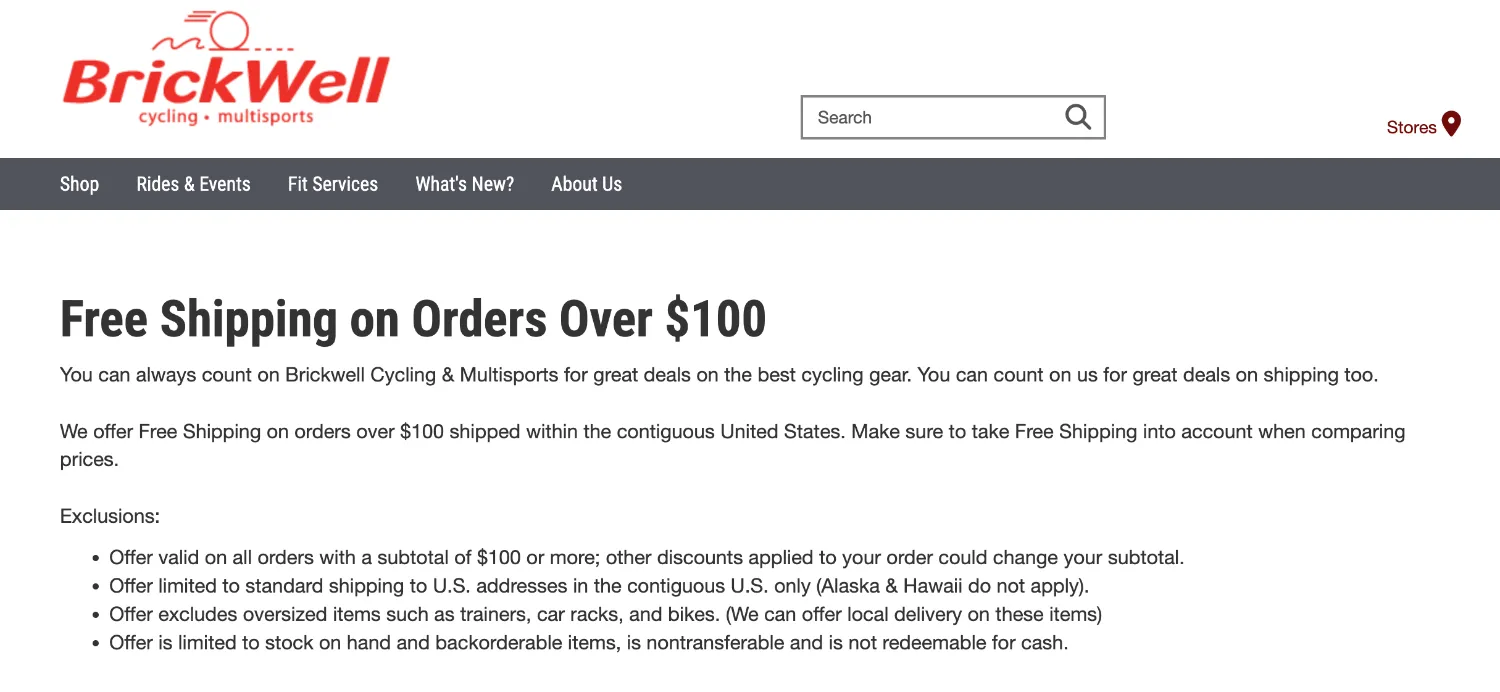
A great example of a brand that offers conditional free shipping is Brickwell Cycling & Multisports. They provide free shipping on orders over $100 within the contiguous United States. This strategy not only encourages customers to increase their order size but also helps them manage shipping costs effectively.
13. Social media contests
Social media contests boost engagement, increase visibility, and attract new customers. These giveaways encourage followers to like, share, or tag friends in posts, expanding audience reach and generating excitement.

Let's take an Instagram post from Dutchtechnerd. The post included clear instructions for participation, such as liking the post, sharing it, or tagging friends. This encourages interaction and increases the likelihood of shares, expanding the brand's reach.
When the contest requires participants to post their own content (like photos or videos), it creates valuable user-generated content that can be shared by the brand, further increasing visibility.
14. Influencer and affiliate promotions
Influencer partnerships and affiliate programs reach new audiences through trusted social media personalities or bloggers. These promotions offer discount codes or affiliate links to the influencer’s followers.
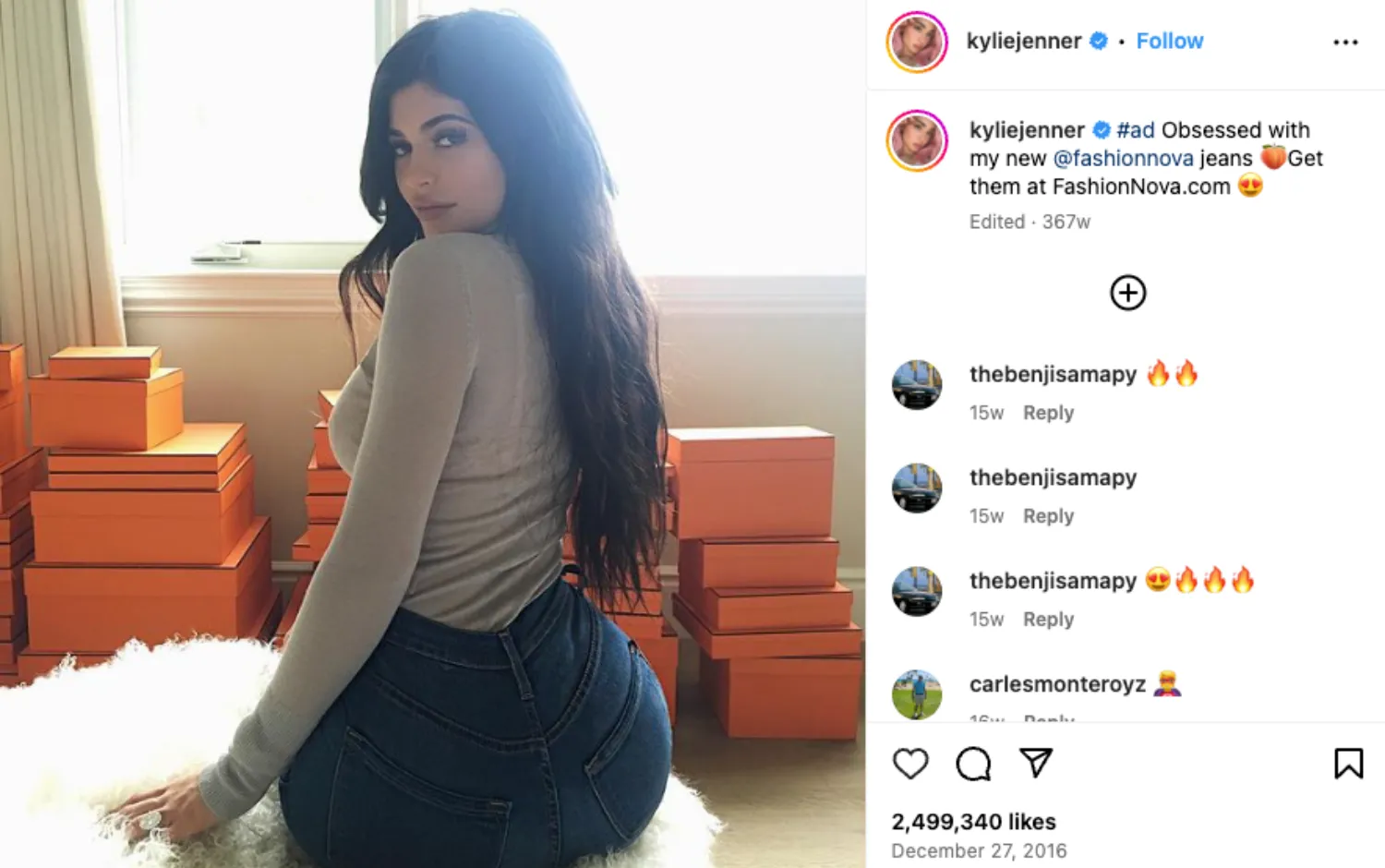
A strong example of a brand effectively utilizing influencer and affiliate promotions is Fashion Nova. They have partnered with many influencers, from major celebrities like Kylie Jenner to smaller fashion bloggers. This strategy includes providing unique discount codes to followers, boosting sales and enhancing engagement on social media.
15. Holiday promotions
Holiday promotions align with consumer shopping habits. Businesses can offer discounts, limited-edition products, or gift-with-purchase offers to boost sales during high-demand periods.

A great example of a brand running holiday-specific promotions for the Fourth of July is Grandin Road. They offer a variety of patriotic decorations and home goods, often featuring discounts during the holiday season. For instance, they have sales on items like flags, wall decor, and outdoor decorations, aligning perfectly with the festive spirit of Independence Day.
16. Newsletter signup discounts
Offering discounts in exchange for newsletter signups helps grow an email list and establish direct communication with potential customers. Once subscribed, businesses can nurture these leads with personalized content and promotions.
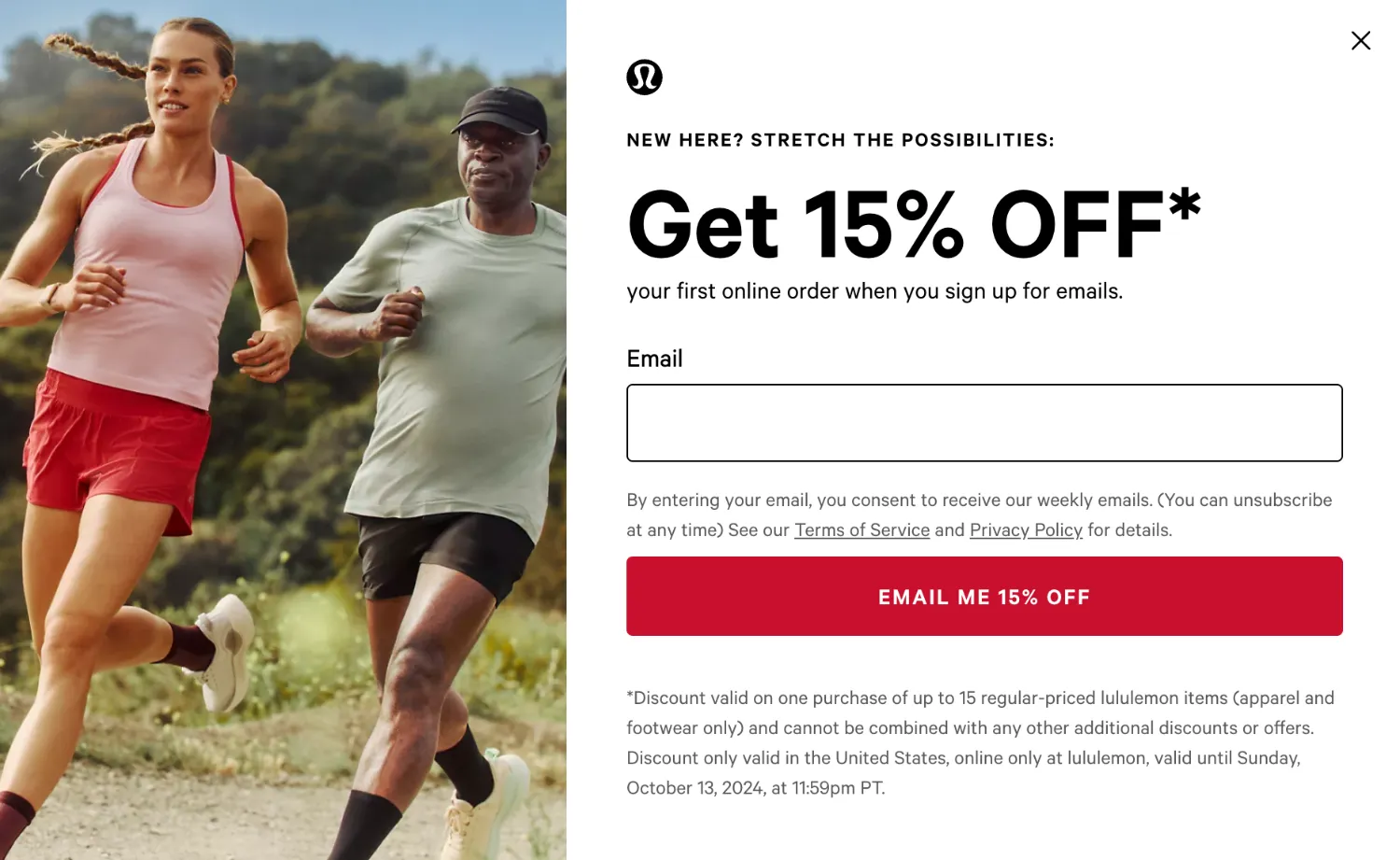
A suitable brand that offers a discount for newsletter signups is Lululemon. They provide a 15% discount to new subscribers as a welcome offer for joining their email list.
17. Cashback offers
Cashback promotions encourage customers to spend by offering a percentage of their purchase back as cash or store credit. This strategy is especially effective for larger purchases.
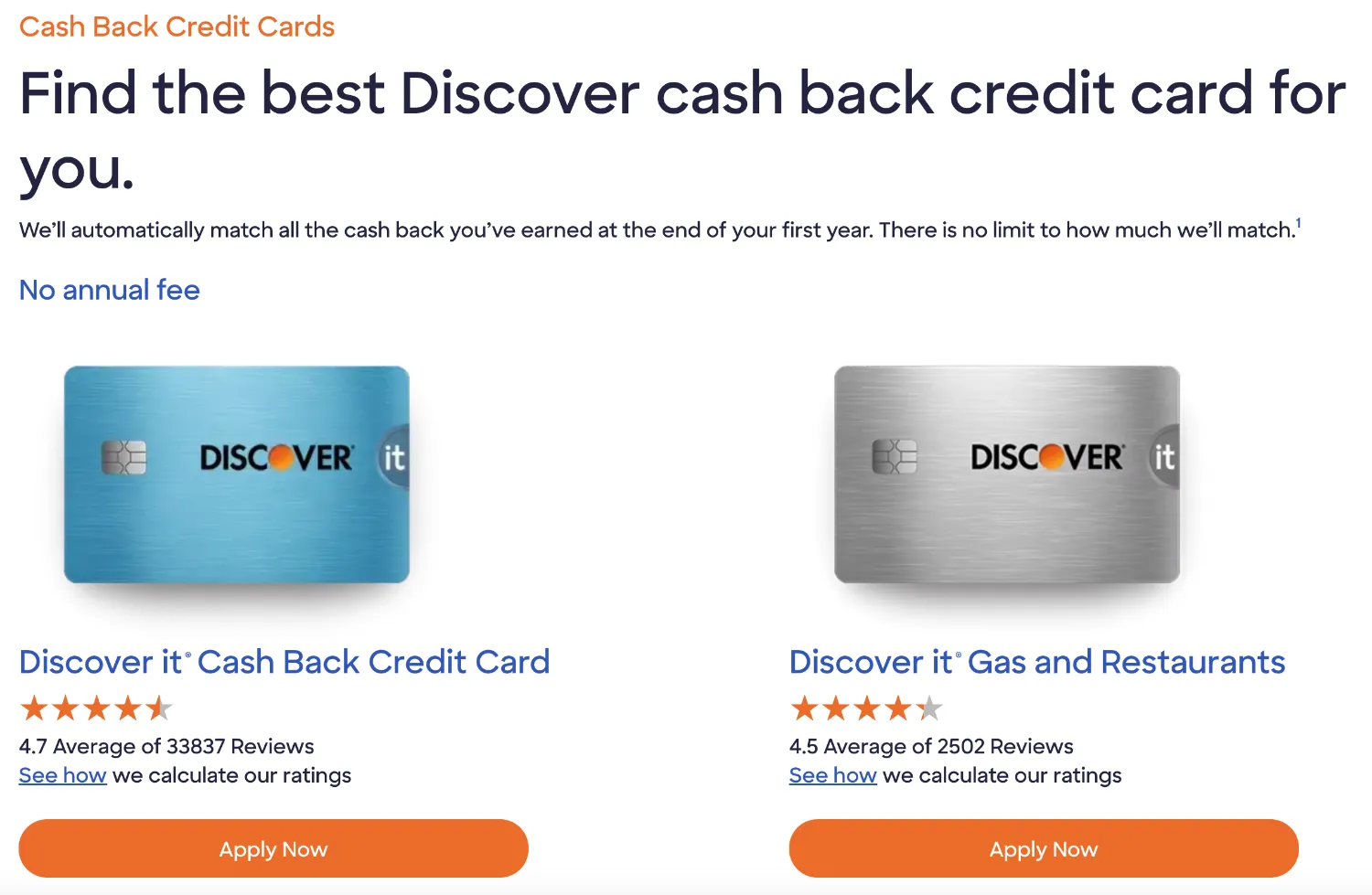
A notable brand that offers cashback promotions is Discover. They frequently provide 5% cashback on various categories, including online purchases during promotional periods, especially around holidays.
Cashback offers increase average order value, particularly for high-ticket items. They also encourage repeat shopping, as customers often use cashback credits for future purchases.
18. Membership offers
Exclusive membership programs reward loyal customers with special discounts, early access to sales, or free gifts. These programs create a sense of belonging, encouraging frequent shopping and making customers feel valued.
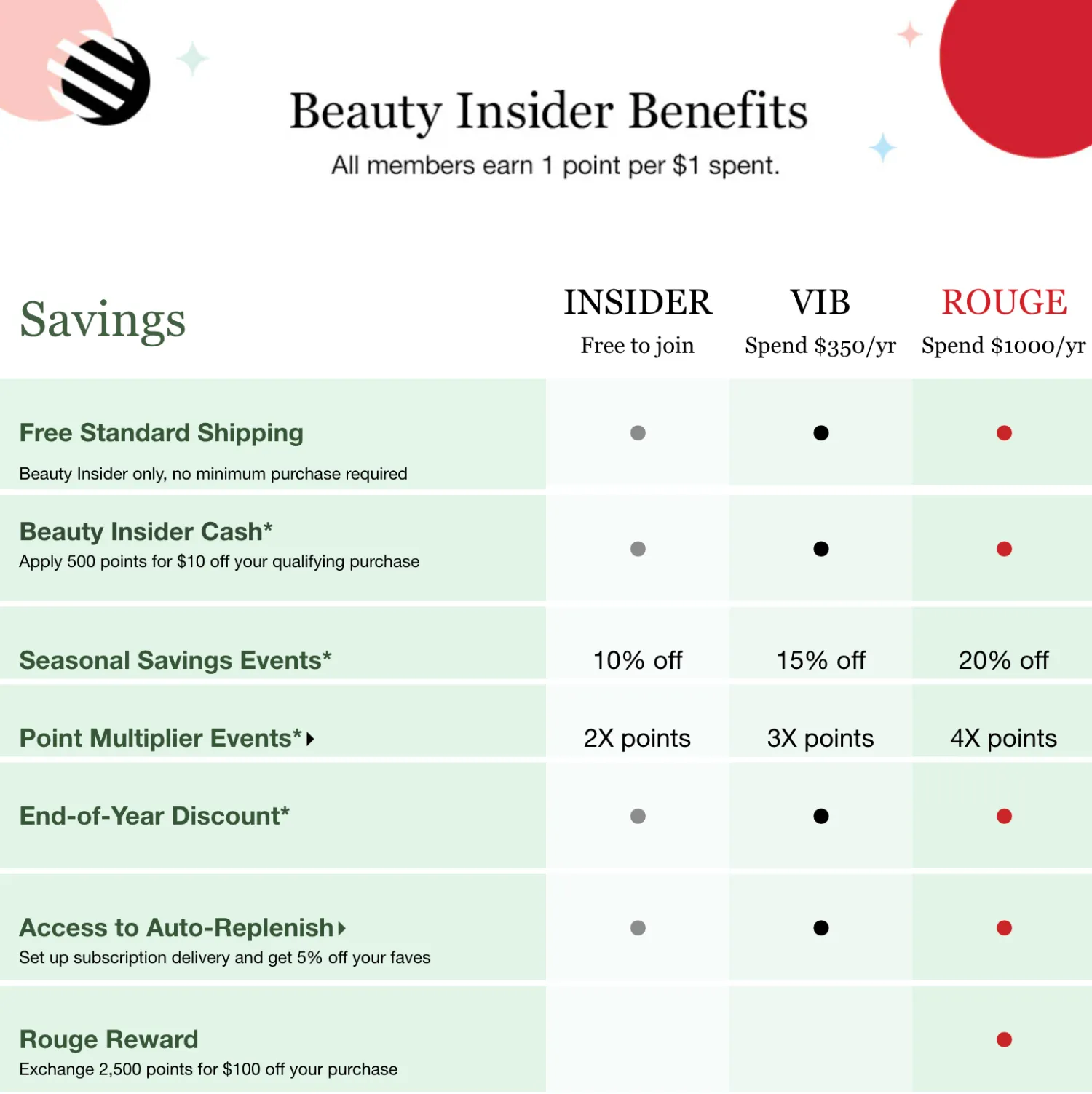
A prime example of a brand offering exclusive membership benefits is Sephora with its Beauty Insider program. Members receive perks such as early access to sales, exclusive discounts during events, and free gifts. This program is designed to foster loyalty and enhance the shopping experience for beauty enthusiasts.
19. Clearance sales
Clearance sales are used to quickly move out-of-season or excess inventory by offering steep discounts. This promotion is particularly useful when businesses need to make room for new products.
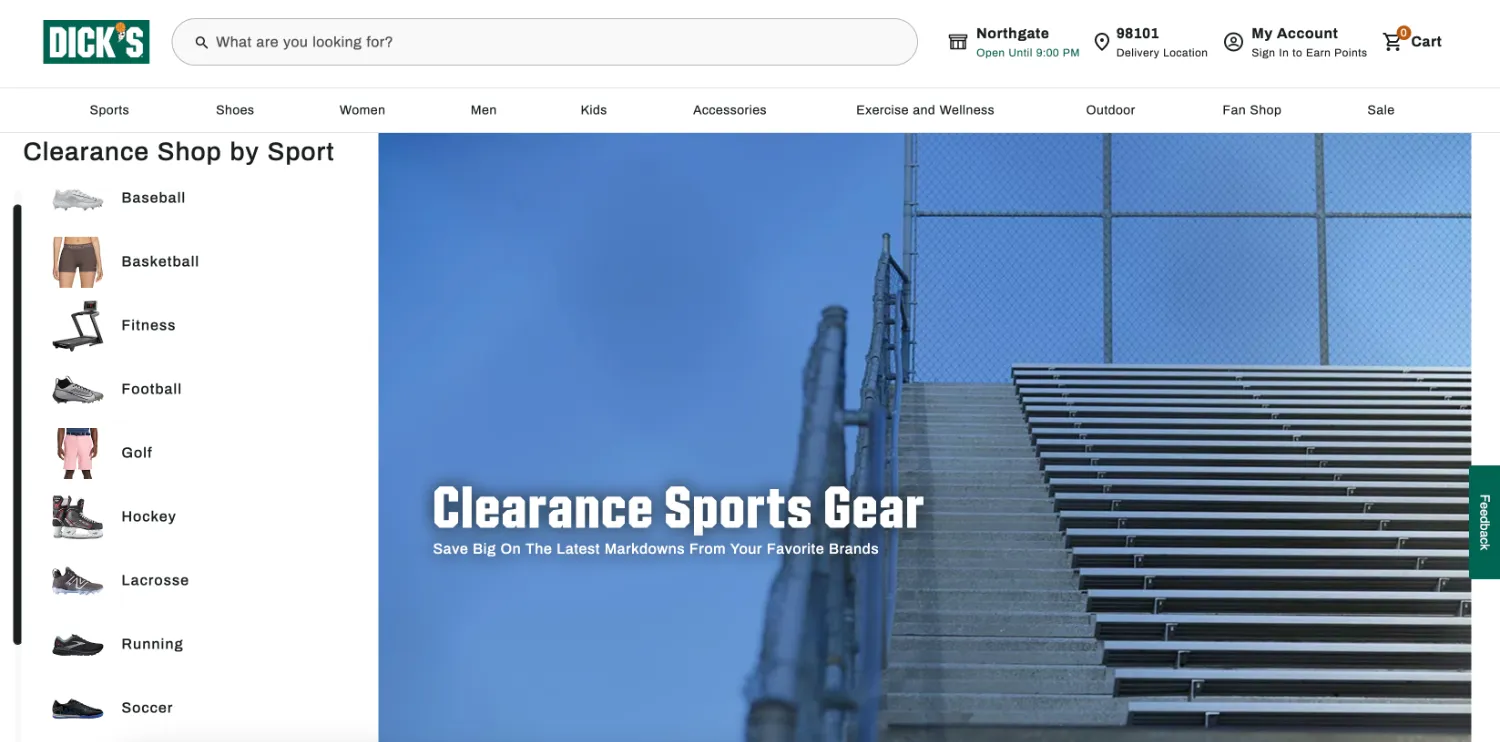
A great example of a brand utilizing clearance sales for overstock items is DICK'S Sporting Goods. This sports brand has a dedicated clearance section where you can find marked-down sports gear across various categories.
20. Early bird specials for pre-orders
Early bird promotions offer discounts or special deals to customers who place pre-orders before a product is officially launched. This strategy generates excitement and early sales, helping businesses forecast demand. Early bird specials are common in industries like tech, fashion, and entertainment, where anticipation for new products or experiences is high.

A notable example of a brand offering early bird specials for pre-orders is Samsung. They provide significant discounts and incentives for customers who pre-order their latest Galaxy S24 series smartphones. For instance, customers can receive up to 60% off on Samsung Care+ plans and discounts on accessories when they place a pre-order.
21. Free shipping for a limited time
Free shipping promotions are a powerful tool for eCommerce businesses, as shipping costs are often a barrier to completing online purchases. This promotion is especially effective when paired with other discounts or time-sensitive offers, motivating customers to take advantage of the deal before it expires.
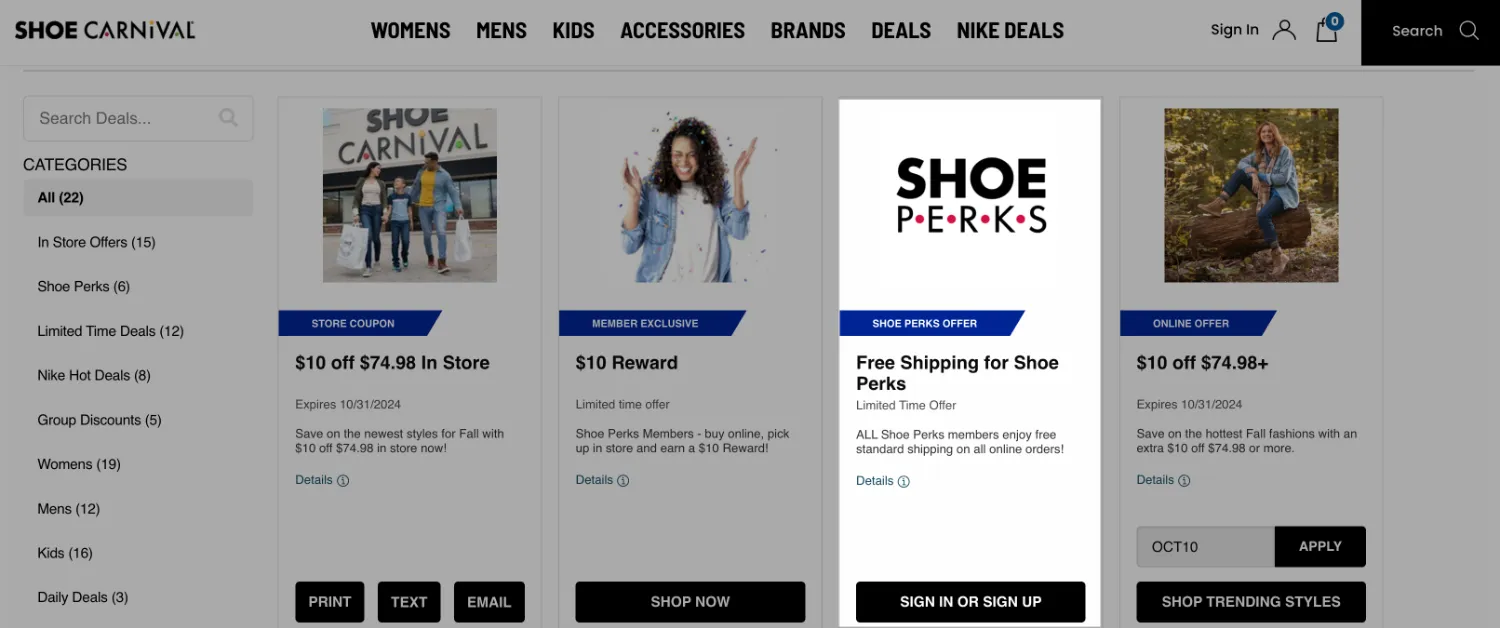
For example, Shoe Carnival is known for its frequent free shipping offers during promotional events, such as back-to-school sales.
22. Digital coupons for online orders
Digital coupons provide instant savings to customers shopping online, making them a convenient and effective way to drive traffic to your website and boost conversions. These coupons can be distributed through email marketing, social media, or digital partnerships, giving customers a direct incentive to purchase.
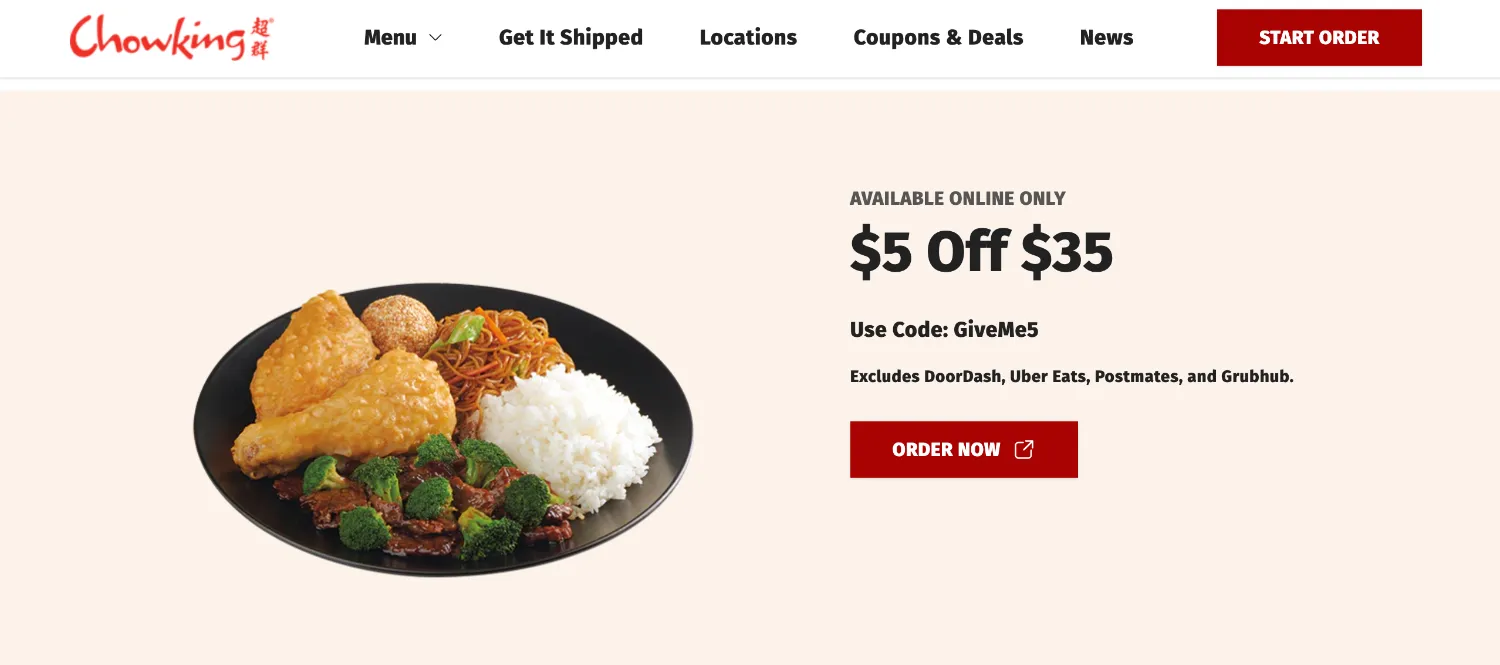
A relevant example of a brand utilizing digital coupons for online orders is Chowking. They offer a $5 discount for first-time users who register and place an online order of at least $35 using the code “Giveme5.” This promotion encourages new customers to try their service while providing immediate savings.
23. Birthday sale promotions
Birthday promotions offer personalized discounts or gifts to customers on their special day. This approach builds a connection with customers and encourages purchases.
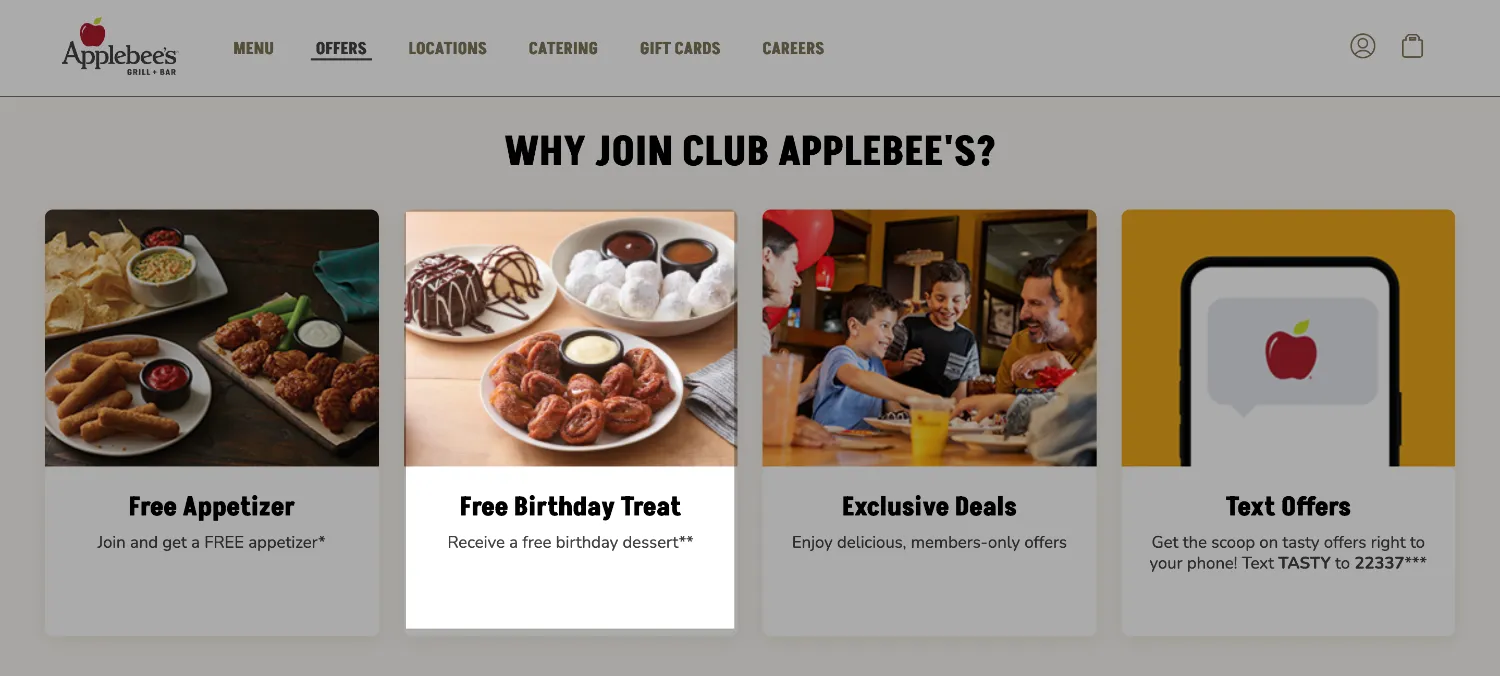
A great example of a brand that offers birthday promotions is Applebee's. They provide a free dessert, entrée, or appetizer to customers celebrating their birthdays when they join their email club, making it a memorable dining experience.
24. Trade-in offers for old products
Trade-in promotions allow customers to exchange their old or unwanted products for credit toward new purchases. This strategy is particularly effective in industries where customers frequently upgrade their devices or equipment, such as electronics or automotive.
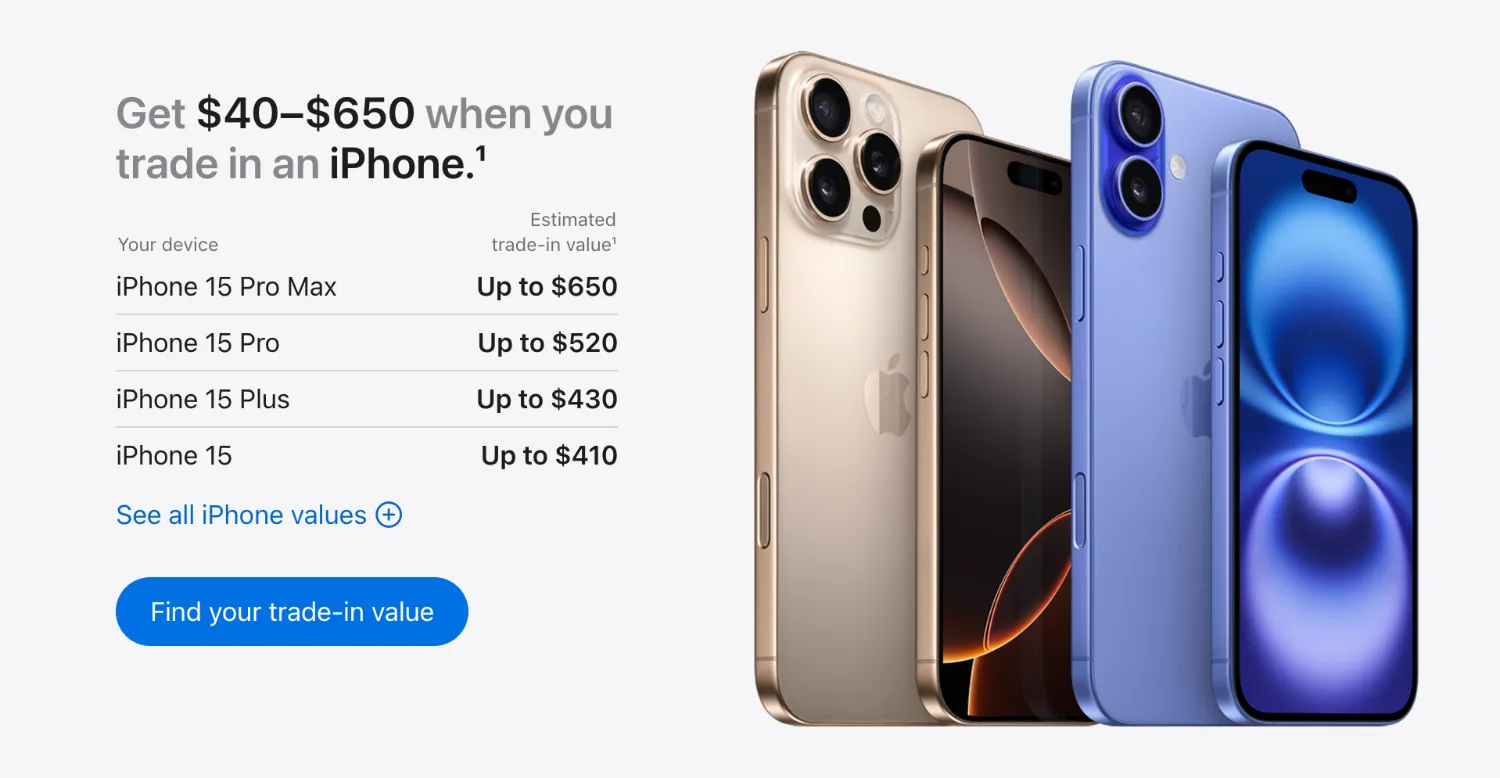
A strong example of a brand offering trade-in promotions for old products is Apple. They have a comprehensive trade-in program that allows customers to exchange their old devices, such as iPhones, iPads, and Macs, for credit toward purchasing new devices. This program provides immediate savings and promotes sustainability by recycling old devices.
25. Giveaways at in-person events
Hosting giveaways at trade shows, pop-up shops, or other in-person events is an effective way to engage potential customers and create a lasting impression. Free samples or branded merchandise given out at events help promote your products and services while building a sense of goodwill with attendees.

One brand that effectively utilizes giveaways at in-person events is Totally Promotional. They offer items like branded pens, tote bags, drinkware, and other merchandise that can be distributed at trade shows or community events, similar to the brewery example you mentioned. These giveaways promote the brand during the event and serve as ongoing marketing tools as attendees use these items in their daily lives.
26. Bundle discounts on related products
Bundling products at a discount encourages customers to buy complementary items together. This strategy increases the overall sale value, as customers perceive greater value in buying a bundle than in purchasing items separately. Bundles are particularly effective for related products, enhancing customer satisfaction.
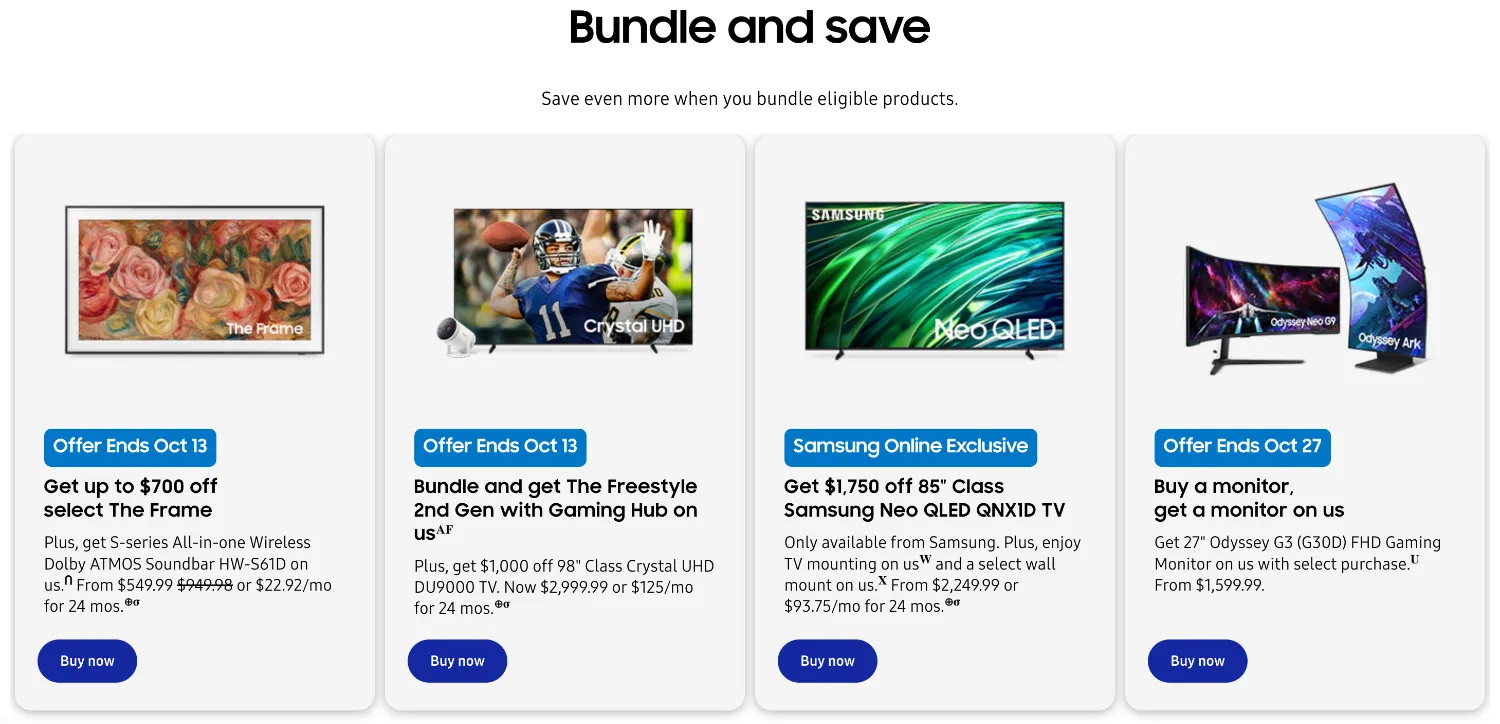
A brand that effectively uses bundle discounts on related products is Samsung. They offer various bundle deals that include complementary items, such as a smartphone bundled with accessories like a case and wireless earbuds at a discounted rate. This strategy encourages customers to purchase more and enhances the overall deal's perceived value.
27. Upsell specials
Upsell promotions encourage customers to purchase higher-end products or add complementary items to their cart by offering discounts or special deals on those upgrades. This strategy works particularly well for businesses that sell products with premium options or add-ons.

Grammarly effectively uses upsell promotions by offering special deals on premium subscriptions during key occasions. For example, they often provide discounts on their premium service during holidays or significant events. This premium tier includes advanced features like tone suggestions and full-sentence rewrites, encouraging users to upgrade for a better writing experience.
28. Donation-based promotions
Aligning your business with a charitable cause through donation-based promotions can drive sales and improve your brand image. This type of promotion allows customers to contribute to a cause they care about while shopping, creating a sense of shared value between the business and its customers.
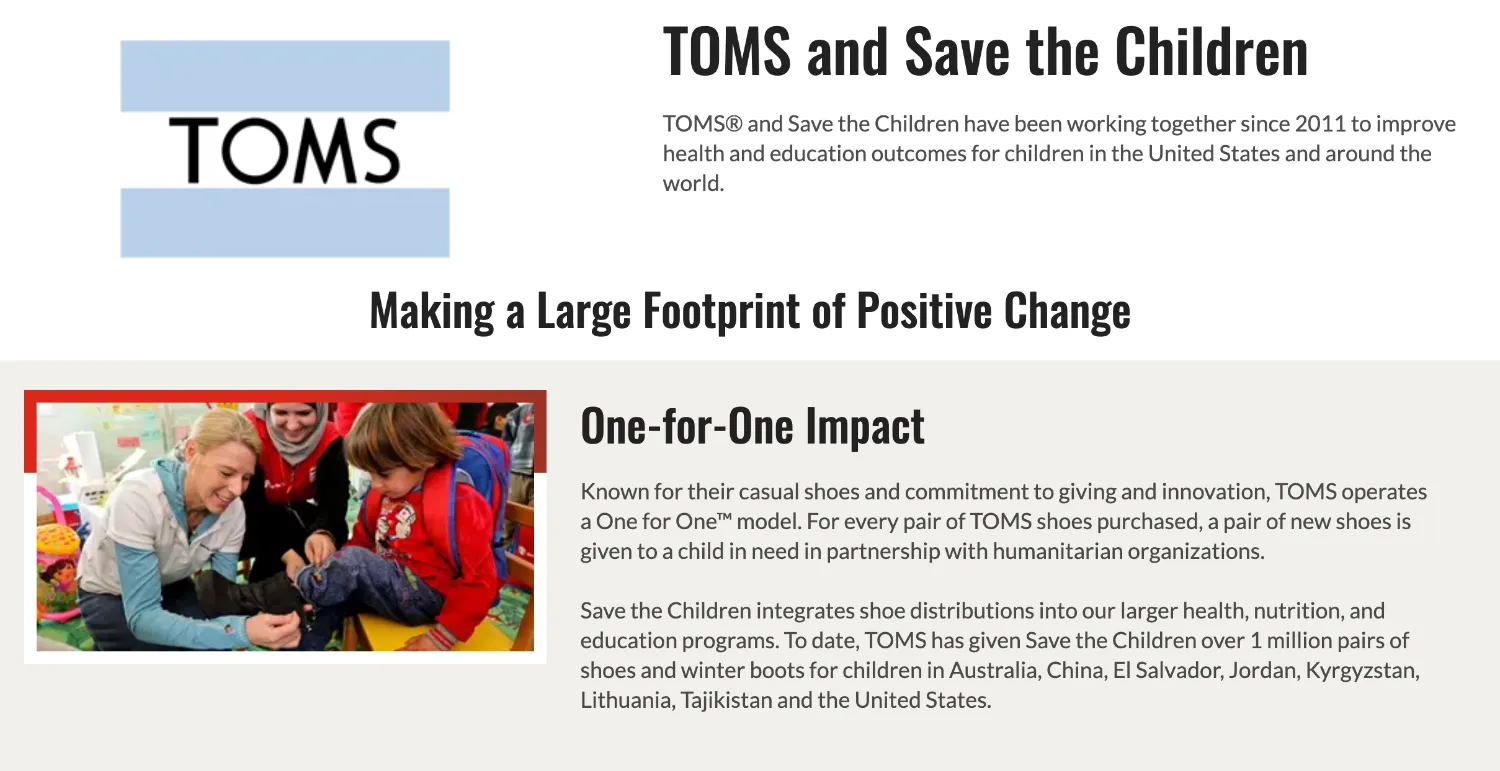
A brand that effectively utilizes donation-based promotions is TOMS. They operate on a One-for-One model, where they donate a pair to a child in need for every pair of shoes purchased. This initiative drives sales and aligns the brand with a charitable cause, creating a strong sense of shared value between TOMS and its customers.
Where to Share Your Sales Promotions?
Social media platforms (Facebook, Instagram, Twitter)
Social media is one of the most effective ways to reach a large audience quickly. Each platform has unique features to promote your sales creatively:
- Use Facebook Ads or organic posts to promote sales, or create an event for special in-store promotions or online sales events. Facebook Stories work well for limited-time deals, and Facebook Groups help with community promotions.
- Instagram’s visual style is great for showcasing sales. Use Stories, Reels, or posts to highlight products, give sneak peeks, or create urgency with countdowns. Instagram Shopping also allows customers to purchase directly from your posts.
- Twitter is perfect for real-time promotions like flash sales. Its fast pace helps generate excitement with last-minute offers.
Email marketing campaigns
Email marketing is one of the most direct ways to share promotions. You can personalize offers to appeal to different customer groups by targeting specific audience segments.
- Newsletter signups: Offer discounts or early access to sales for your subscribers.
- Email segmentation: Send targeted promotions based on customer purchase history or interests.
- Automated campaigns: Trigger emails to remind customers of limited-time offers or abandoned carts.
Website banners and popups
Website banners and popups are effective for promoting ongoing or time-limited offers to visitors. Well-placed banners can drive traffic to specific sales pages, while popups can grab attention quickly.
- Banners: Use bold banners on your homepage to advertise promotions or free shipping.
- Popups: Create popups offering discounts or deals after visitors spend time on your site.
Google Business posts
If your business relies on local customers, Google Business posts are a great way to share promotions. These posts can boost foot traffic or increase online conversions. For example, a local restaurant might post a “buy one, get one free” lunch deal, attracting customers searching for nearby dining options.
In-store and offline promotions
For brick-and-mortar stores, in-store promotions are still important. Complement online efforts with in-store deals to attract customers who prefer shopping offline. Flyers, window signs, and banners can promote your latest sales and encourage impulse buys.
For example, you can offer loyalty cards, “today only” flash sales, or special events where customers can win prizes or receive gifts. You can also use QR codes to link in-store customers to online promotions.
Key Takeaways and Best Practices
Sales promotion examples can be a powerful tool to drive short-term sales, boost customer engagement, and increase brand visibility. However, to maximize the effectiveness of your promotions, it’s important to follow key best practices that align with your business goals and your audience’s needs.
Crafting the right message for your promotion
The success of a sales promotion depends on how well you communicate it to your audience. Your message should be clear, concise, and compelling, motivating customers to act quickly.
- Clearly explain the promotion and its value (e.g., “20% off your first purchase” or “Free shipping on orders over $50”).
- Use phrases like “limited-time offer” or “sale ends soon” to encourage quick action.
- Keep the tone of your promotion consistent with your brand, whether it’s fun, professional, or innovative.
Avoid over-relying on discounts
While discounts are popular, relying on them too much can lower your brand’s perceived value and hurt profits. It's important to balance discounts with other types of promotions.
- Use a mix of promotions, like free gifts, loyalty rewards, or contests.
- Instead of just cutting prices, consider adding value by bundling products, offering exclusive content, or providing enhanced customer service.
Integrate sales promotions into your marketing strategy
For maximum impact, integrate your sales promotions into your overall marketing plan. This ensures consistent messaging and helps align promotions with your long-term goals.
- Make sure your promotional messages are consistent on social media, email, and in-store materials.
- Schedule your promotions around holidays, product launches, or seasonal events to capture high-traffic periods.
Tailor promotions based on customer behavior
Understanding your customers is key to creating promotions that resonate with them. Use data and insights to personalize offers based on their specific needs.
- Design different promotions for various customer groups, like first-time buyers, loyal customers, or high spenders.
- Use purchase history and browsing behavior to guide your promotion strategy.
Sales Promotion Examples: FAQs
What are examples of a sales promotion?
Sales promotions can take many forms depending on your business goals and target audience. Common examples of sales promotion include: Discounts: Percentage-off sales (e.g., “20% off”), sitewide discounts, or limited-time offers.
BOGO (Buy One, Get One): Purchase one product and receive another free or at a discount.
Free shipping: Offering free shipping on orders over a certain amount.
Loyalty rewards: Providing points or exclusive discounts to returning customers.
Flash sales: Short-term, time-sensitive promotions to create urgency.
What does sales promotion mean?
A sales promotion refers to short-term marketing strategies designed to stimulate quicker or larger purchases by offering incentives such as discounts, free gifts, or special deals. These promotions aim to create urgency, boost sales, and drive customer engagement, usually for a specific time frame.
Which sales promotion is most effective?
The most effective sales promotion depends on your target audience and business objectives. For example:
- Discounts and BOGO offers work well for attracting new customers or clearing out inventory.
- Loyalty programs are best promotion ideas for retaining existing customers and encouraging repeat purchases.
- Flash sales can create urgency and generate a spike in short-term sales.
The effectiveness of a promotion is also influenced by timing (e.g., holiday sales) and how well it aligns with customer preferences.
What are the five methods of sales promotion?
The five common methods of sales promotion include:
- Discounts and coupons: Price reductions that incentivize purchases.
- Loyalty programs: Rewards for repeat customers.
- Contests and giveaways: Promotions that encourage customer participation for a chance to win prizes.
- Free samples: Offering free products to entice customers to try something new.
- Limited-time offers: Creating urgency through time-bound promotions to drive quick sales.
Final Words
Sales promotions are a strong tool for driving sales and increasing customer engagement. They also help build long-term customer loyalty.
However, businesses must approach sales promotions strategically. Each promotion should align with the company’s marketing goals and brand identity. As you plan your next campaign, you can consider a variety of options like discounts, loyalty programs, flash sales, or free gifts.
We hope you found these 28 sales promotion examples insightful and helpful for your business growth. For more related content, visit our Store Growth section on the website. Also, join our Facebook community to connect with other business owners and stay updated on the latest strategies for success.

